Wednesday, May 31, 2006
Letter to Polt: Metric On the Empire
Polt: Thanks for the conversion from Celsius, your non-Metric American readers appreciate it. :)
Actually, as I was remarking to P-Doug the other day, in spite of the fact I was educated from start to finish in Metric, Celsius temps only "work" for me when it's cold. Zero is freezing? That makes sense to me. But 20... is that really warm, or do I need a jacket, or what? But I know 60 in Fahrenheit is about when I can go bare-armed, 70's pleasant, 80's hot. So I fall back to what Bob and Doug told me years ago on The Great White North album: "double it and add 30". 20, 20, 30, that's 70. Okay, jacket stays home. :D
I find my life is a curious and often contradictory mix of Metric and imperial. The imperial I come by strictly culturally; from the very first day I started school in the early 70s, I was taught in Metric and Metric only. I undertand the Metric system and I've often said "I have no sympathy for anyone who can't count to ten," but that said, I am in practical terms unfaithful to the official measurement system of my country...
I think this can be generally said of Canadians, though. I remember that in the 70s, for a while, it was actually illegal to put imperial weight and volumes on products, but evenutally the government relented and said it was permissible so long as the official Metric measurements were included. Now if they hadn't done that and they'd stuck to their guns, I probably wouldn't have the practical experience with imperial I do have, and I might not rely on it as much as I do.
Here's how it works for me. (Temperatures are discussed above, so I'll avoid redundancy on that score.)
Linear measurements: I tend to reckon speeds in kilometres, but distances in imperial: inches, feet, miles. Something about the direct proportion of 60 miles in 60 minutes is just too convenient to shake off, and I find myself multiplying kilometre measurements by 0.6 to get an idea of how many minutes that's going to take me to cover... what I'm really doing there is figuring out how many miles it is.
Volumes: litres work just fine for me for milk and gas, and pretty much anything else. But when it comes to beer and booze, you're talking ounces and pints (real pints, not those pissy little ones they have in the States). This, I think, is extremely common in Canada. Beer and pop are sold in 355 mL cans, but in reality, that's exactly 12 oz (US). There are some Metric sizes, of course, like litres and 750 mL bottles, but some 'comfy' standards die hard.
Weights: pounds. Pounds pounds pounds pounds pounds. I can picture holding a pound of butter in my palm; I know that that is. Kilograms... I don't know, I just never latched onto the concept. I know what I weigh in pounds (don't ask), I know how far a pound of meat goes, I know what a quarter pounder is, I know how many ounces an average chicken breast is.
The weight thing brings me to the heart of the matter. I think the reason I have such trouble really, practically adopting so many Metric measurements is that they seem divorced from everyday use. Metric was formulated out of scientific principles, usually tied to water (1 cubic centimetre of water at a certain temperature is 1 gram; it freezes or melts at 0 Celsius...). And on a logical level, I deeply admire that. But it results in measurements that don't seem practical to me. They're either too large, or too small. A gram is too ridiculously small. A kilogram, on the other hand, is too large. Conversely, an ounce is something you can typically hold in your fingertips; a pound, in the palm of your hand. A foot is easy to visualize; hold your hands out in front of you a comfortable distance, and that's about a foot. A metre is a little harder to visualize; again, it's just too big somehow. Even when I was a kid learning Metric in school, all the "Metric" rulers were 30 cm long... in other words, a foot. A square foot is easy to picture; a square metre rather more elusive (more on this in a moment, though). The only everyday Metric measurement I'm at home with is the litre, and that's probably because, by sheer serendipity, it's nearly the same as a quart... milk cartons got a little skinnier when I was a kid, enough that I could tell, but not enough that it made a difference carting it home from the store. So, all things considered, it's hard for me to imagine a time when imperial will be behind me.
Housing standards, even now, seem to have stayed almost completely imperial, though. But that said, something interesting happened several years ago when my parents put their house on the market. I was helping them measure the square footage of the rooms, and they told me that the Toronto Real Estate Board wanted the measurements in square metres. And I thought, who the hell wants to know the "square metreage" of a house? But when we came to do the math, I suddenly realized why they suggested it, and why we use Metric in the first place. Multiplying 387.4 cm by 258.5 cm is a piece of cake. Trying multiplying 15'9¼" by 11'3¾" sometime. But if you get the m², all you have to do to get the evil square footage is multiply by 10.7639104 (call it 10.75 and be done with it). 19.25 m² is about 207 square feet; two measurements, two math chores and you're done. Okay, sometimes, Metric wins. :)
Tuesday, May 30, 2006
Very scary customer

Partial script from "The Usual Sort of Thing in British History"
Note to the reader: this just sort of popped into my head this morning and I went with it; I think it was inspired by my successful use of the word "camouflage" in the previous post. With tongue firmly in cheek, enjoy. :)
-----
EXT.: Brock's Monument, Queenston Heights, Ontario, Canada.
SNOOTY BRITISH PROFESSOR enters from stage left.
SNOOTY BRITISH PROFESSOR
"It was more or less at this moment that General Brock, ascending the rise in bright red camouflage, was picked out and picked off by an American sharpshooter upon the Heights; the results of which you see here, in the form of Brock's Monument."
SNOOTY BRITISH PROFESSOR exits, stage right.
Camera trucks to monument, zooms in on statue of Brock.
EXT.: the view overlooking Queenston and the Niagara River.
Camera pans, slowly, left to right, throughout monologue.
SNOOTY BRITISH PROFESSOR (offscreen)
"Command then passed to Lieutenant-Colonel Macdonnell, that rarest of all creatures, a Canadian-bred officer in the British army. Macdonnell's kind was rendered rarer still when he himself was shot down in a subsequent charge on the Heights."
EXT.: walkway along the Heights.
SNOOTY BRITISH PROFESSOR enters from stage left, walking; camera tracks with him as he walks.
SNOOTY BRITISH PROFESSOR
"In the end, forty-four million men, or thereabouts, were cut down in approximately nine seconds in the various assaults on the American position, held by fourteen men and a three-legged horse. It was, in most respects, a typical British victory; sustaining a long tradition going back at least as far as the Viking invasions, and pointing the way proudly forward to the battles of the First World War."
Camera stops; SNOOTY BRITISH PROFESSOR exits, stage right.
Monday, May 29, 2006
A bridge, a creek, three cameras and me
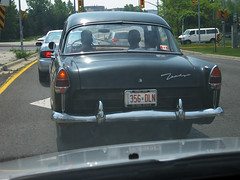
Just as I was turning onto the 404 southbound to get onto the 401 eastbound, I encountered this car. According to the frame of the license plate, this is a a 1959 Ford Zephyr. I ended up following this car most of the way across Scarborough before it driffed into the express lanes and I remained in the collectors.
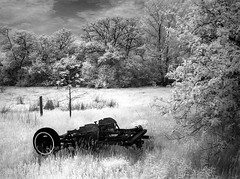
On arriving in Bowmanville, I parked my car and crossed a street, entering a field. If my maps are to be believed, the scoured surface of the field, and the bridge it leads to, recently carried a spur of the CN line just sound of the 401 up to a factor on the north side. As I corned a small copse of trees, I was greeted with the sight of this abandoned piece of farm equipment. Note to the viewer: any black and white shots you see in this post are in fact infrared images taken with my Canon G1, which has been converted to take such shots. They're also high dynamic range images composed of three photographs each, one -2 EV, one 0 EV, and one +2 EV as their exposures. I love infrared photography. It makes everything look like 1950 or something.
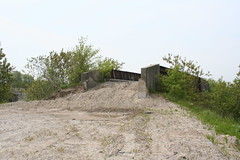
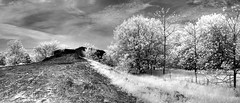
This is, in visible light and infrared, the rise leading up to the bridge itself. If it did carry railroad tracks till recently, this rise must (obviously) have been more gradual than it is here; it's a bit of a climb of about 15 feet on the approach and a nearly straight drop of about 30 on the far side! It would seem the risers on either side have been deliberately removed. Perhaps the bridge itself is next?

This is a panorama view of the surface of the road surface, taken as I climbed up. This view looks west.
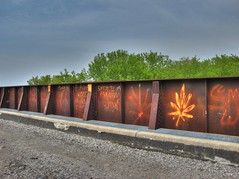
This is the only high dynamic range colour image I created from the shots I took that day. My excursion gave me opportunities to use all three of my Canon cameras — the G1 for infrared shots, the Rebel XT for long shots, and my new S80 for... pretty much everything else. The S80 is quickly proving to be my Swiss Army knife of cameras. The S80 took the three images that were combined to make this HDR shot here.
I wish I could tell you that leaf is a maple leaf... but it ain't. It was more the love of pharmacology than of Canada that inspired that doodle.

I crossed the bridge and came to the other side. It's hard to tell from this shot, also a panorama, just how abrupt the drop is; in the dark, someone might plunge from this spot and potentially kill themselves. It's not quite a straight drop, but I'd say it's a 75 or 80-degree drop. As you can judge from the height above the trees, it's about 30 feet to the ground.
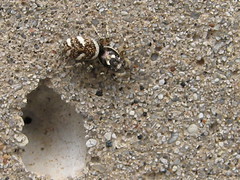
Just before I headed down, I noticed one of those tiny spiders. I've always called them "brick spiders" or "jumping spiders"; I have no idea what they're really called. I remember them from when I was a boy in Nova Scotia; typically, I would notice them on the brick cladding of houses. Brick in Nova Scotia was almost universally clay red, and these spiders stood out. You can see that their camouflage works much better in situations like this (note to the reader: this instance of the word "camouflage" represents the very first time in my entire life I've spelled that word properly entirely on my own. Yay for me).
Incidentally, this is another shot taken with the S80, using the digital macro setting. I find myself more and more amazed by this camera. The Rebel XT, even with a 28-135 lens with macro capacity, came nowhere near this level of magnification when I put it to the test.
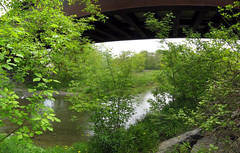
Though the dropoff at the lip of the bridge was severe, it was still possible, just barely, to slip off to the side where the rise still met the side of the bridge, and trot down in a friendlier, grass slope of about 50 degrees. I made my way around to the riverbank itself on the northwest side of the bridge.
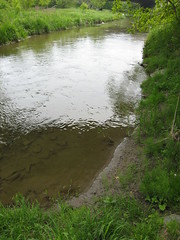
It was a pleasant enough location; I poked around for about ten minutes before finally determining to ford the creek. It looked to me to be not quite three feet deep at its deepest, and since I was in shorts, this presented no real obstacle. My real concern was that, between the G1, the S80, the Rebel XT and the EF 28-135 IS lens, I was carrying about three grand worth of camera equipment around my neck and shoulders. But I'm a determined creek wader, come the good weather, so I decided to indulge myself, with due caution. You're looking here at my chosen point of embarkation.
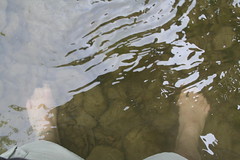
The riverbed was soft and silty, not slippery. The water itself was cool, but not numbing; I found it very refreshing. It was too cold to have been comfortable to swim or sit in, but for wading, it was just warm enough.


Here you see two sets of shots taken at the midpoint of the creek, looking north. They're both panorama shots; the infrared one is composed of, if memory serves, nine separate exposures of three sets each, made into HDR images that were themselves stitched into a panorama.
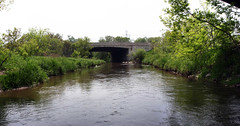
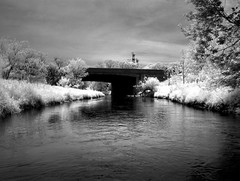
Another pair of images, again contrasting visible and infrared, this time looking south to the bridge that carries Highway 401, the very backbone of southern Ontario, over Bowmanville Creek, in which I was standing mid-stream. As a matter of fact, I spent ten or fifteen minutes crossing the creek, though if I'd had a mind to, I could have made the transit in a minute or less. But I was in no way in a mood to rush the very pleasant journey... I've waited too long for spring. :)
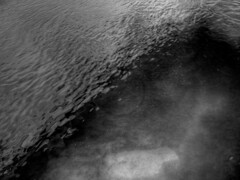
This is an infrared HDR image showing the ripples and waves of the creek as it passed me, and, surprisingly, elements of the riverbed itself that cannot be discerned in any of the three images that actually went into making this shot. This is the magic, the occasional magic at least, of high dynamic range imagery. There's so much information hidden in the shots we take, just waiting to be teased out...
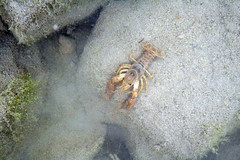
I took several shots of this little guy, and this is the one I liked best. This is, if I'm not mistaken, a crayfish, or crawdad. I was amazed to see it; I had no idea they lived this far north. As a native Nova Scotian, I'm familiar with lobsters, but I think this is the very first time in my life I've ever seen a crayfish, at least that I remember. I had assumed them to be characteristic of the US south, but apparently they're to be found in the Great Lakes river valleys as well. This one was rather forward... it sat for a few moments, and then began, slowly but inexorably, to advance on me. I found it unnerving... aren't these things supposed to be afraid of us? With all the equipment I was carrying, I had no desire to be pinched or nibbled or whatever it had in mind. This little 4" lord of the creek moved me along, I'm ashamed to admit.
The image itself is retouched in Photoshop, using the autolevels command. It did a fantastic job, clearing away the murk and the brown cast. You'd hardly know this little bug was over a foot underwater, would you?
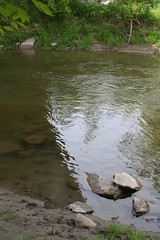
When I got to the far side of the creek, I stopped to consider the little trip. What you're seeing here is the route I took to ford the creek from one side to the other.
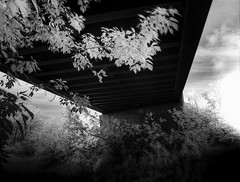
I noticed the leaves of the trees under the bridge. Always mindful that foliage appears white in near infrared light (that is, the leaves powerfully reflect it), I decided to see what the G1 would make of the scene. The leaves were far more pronounced against the dark steel background in IR light than in visible light; they yielded this stunning and rather surreal contrast, seemingly in defiance of common sense notions of light and dark. It doesn't seem that the leaves have any business being this bright in the shade, and yet they are...
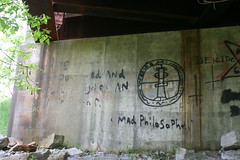
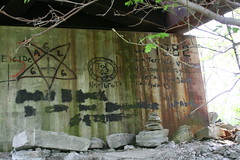
On this side of the bridge (which was built, as you can see from the date impression in the upper right, in 1982... surprisingly recently), there was a collection of somewhat satanic graffiti. Who knows how long it's been there, or what was the mindset of the author. I didn't pay it much mind at the time, aside from recording it as a curiosity. It was only in retrospect, hours later when reviewing the shots, that they gave me a vague sense of disquiet. The passage at far right reads, "I have had a terrible vision of my universal kingdom that awaits." Corny line from a bad 80s horror flick... but I'm still glad I didn't bump into the author.
Incidentally, if you happen to click on the image and investigate it large, check out the stack of flat rocks just under that passage in the right-side image: perhaps the world's least-inspiring inuksuk. :)
This side of the bridge was rocky, but having taken my sandals off and slipped them into my cargo pocket, I determined to carry on barefoot, and remained so until I set out to leave, a little over half an hour later.
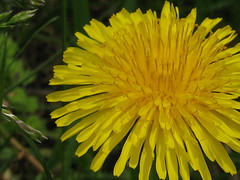
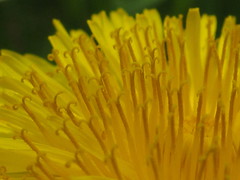
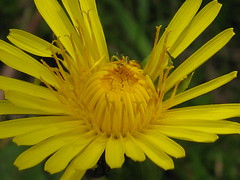
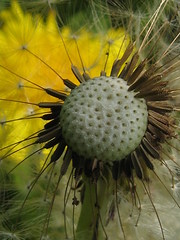
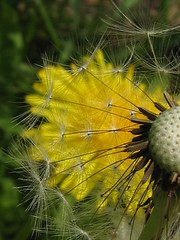
I passed over the rocks to the grassy rise on the northeast side and padded down into pasture land alongside the creek. Here are five digital macro shots of dandelions, taken with the S80. The subject matter is just about as pedestrian as it's possible to get, but I find the images themselves remarkable, especially that second one. The interior petals are rendered sharply in a detail that I've never even seen with the naked eye, and the outlying petals only a half an inch away are in soft focus. Talk about remarkable depth of field.

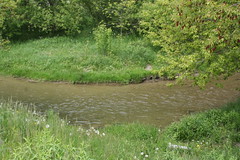
Two views of the bend just north of the bridge; one a panorama, one a straight wide-angle shot.
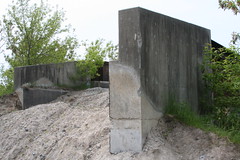
I decided, before I left, to have another look at the bridge. I'd brought along a tripod in hopes of taking shot with the mouth of the bridge in focus in the foreground and the 401 in soft focus in a foreshortened background (what a great shot that would have been, if I could have managed it), but the angles were just not with me. But this is another shot of the approach to the bridge, this time coming up from the field to the north of it.
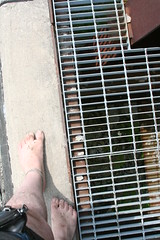
One of the things I did take several shots of were the rain grates along the side. I noticed when I was under the bridge that I could look up and see the sky through it. Conversely, you can look down through the bridge and see the creek and the trees that border it. The concrete was warm and smooth; the steel was hot to the touch.
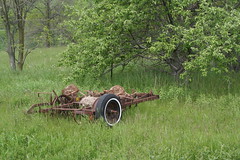
On my way back to the car, I stopped to compose this shot of the abandoned farm equipment. I wanted something with no real hint of the town around it; something that might have been twenty miles from the nearest soul, lost out in the middle of nowhere. I think I pulled it off. What do you think?
Yah want freedom with that?
Is it just me, or have you noticed that lately, the government, institutions, and even the people of the United States are using the word "freedom" a little too blithely? I don't know... it's like a sort of mantra, something uttered to soothe a troubled soul, like "Jesus loves you" or "it'll all be over by Christmas".
I've noticed that ever since the Reagan administration, the word's been minted with the same sort of disregard as the Federal Reserve Bank's been printing unbacked US currency. Just keep cranking out the word and spreading it around and hope nobody notices how cheap it's getting. I remember when the International Space Station was supposed to be a US-only effort to be called "Freedom", do you? I think that was the first time I found myself taking issue with the use of the word. There was a presumption about it I didn't care for...
Let me come to the heart of my objections. First of all, the word is being used too, shall we say, liberally. Have you ever noticed that if you say a word often enough, it starts to loose meaning and becomes just a weird sound coming out of your mouth (a really good word to experiment with is "clean"... say it over and over for half a minute and you'll see what I mean). It starts to sound foreign. This is one problem with the way the word's being used. George Bush uses the word to stifle opposition, grease the wheels of military deployment, justify staggering deficits, subvert civil liberties (how's that for ironic?) and allow the use of torture, overthrow foreign governments and needlessly slaughter civilians (pardon me, "collateral")... Operations are called "freedom". Awards are called "freedom". Medals are called "freedom". Even in World War II the word wasn't bandied about like this. "Liberty", which to me connotes a higher, more formal political idea, was the order of the day back then. "Freedom" sounds more personal, and little more hinky... like your parents not actually objecting if you blow off chemistry class to go to the mall.
My other objection is to the subtle, but palpable, usurpation of the word. People in the US have pretty effectively done this with the word "America", reserving it to themselves when in truth it belongs to everyone in this hemisphere. Now, increasingly, it's being done with the word "freedom". The suggestion is that "freedom" is really a function of living in, being of, or serving the interests of the United States. Other people may pretend to it, but their versions are quaint, ersatz, and approximations at best. This attitude is obvious in such uses as "freedom fries", a deliberate jab at the French: implicitly, the freedom of the French nation is to be scoffed at, denied, derided, all for the sin of objecting to the military brutalization of a country that did not attack the United States. This use in particular is objectionable and offensive; others less so. But the fact remains that the people of the US are sticking the word on ideas and concepts the way corporations ply the words "new!" and "improved!" until they're utterly worthless; de rigeur to a sales pitch.
Equally cheaped by overexposure, especially lately, is the US flag. Always proud to show it, they have gone to extremes lately. The thing is to be seen draped everywhere, even over disaster sites, as though a coloured cloth, a symbol, had the power to retroactively defend the dead, or erase the event, or deny the presence, power, and even the existence of others in the world; a multicoloured bandaid of pride alone that purports to magically heal all wounds; a use that seems to me vaguely inappropriate and slightly disrespectful to the flag, and, dare I say, faintly silly, like holding up a cross to ward off vampires. And where one used to do on a building or a bridge or a monument, now scores of the same are demanded, until the thing becomes of little more consequence, prominence, or meaning than the myriad dishrags stuck into any convenient corner of the kitchen of a greasy spoon, readily at hand to wipe a dish at a moment's notice — or in this case, reassure the viewer that he is still someplace safe and familiar and has not slipped into some strange foreign land which, in spite of the best efforts of 50 years of global Americanization, may stubbornly adhere to their own ways. I can't help but see this as whistling in a graveyard; as if the more flags there are, the louder the chants of "USA!" are, and the more the word freedom is splashed around like verbal whitewash, all adds up to the more hydrogen still left in those fifty stars, and the easier it is to ignore the fact that they have, in fact, begun fusing helium, economically, politically, and militarily, and that nothing practical that might head off or at least ameliorate it needs to be done about it.
Street racing, what a gas
That, in nut shell, is my bone of contention. Why is it that pretty much always always always, it's the same story? Two fuckheaded students who've never raised a single bead of sweat on their nuts for anything, handed four-wheeled penis extensions by their over-funded, under-braincelled parents, idiotically end the lives of innocent people and live to tell the tale? Why is it that almost without exception, the people who are just getting on with their lives get their tickets punched, while you can bet this month's salary the assholes who killed them continue breathing — literal oxygen thieves? Is this another one of God's little jokes, like steering tornadoes through trailer parks?
Friday, May 26, 2006
A look at home
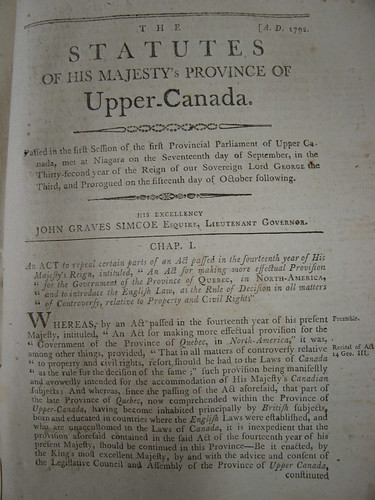
Ontario was essentially founded by Americans leaving the United States after the Revolution. There has never been a time in our history when that dichotomy has not been a factor in who we are and what we fear to become. So, relatedly, I also found another remarkable record, completely by accident. Paul was showing me the pamphlets on record, and pulled down one from the 1860s, prior to Canada becoming a nation in 1867. In it was a speech by Thomas D'Arcy McGee, an Irish immigrant who was one of the Fathers of Confederation. McGee was always enthusiastic about creating a union of the British North American colonies, and he did live just long enough to see it happen, before he was assassinated in April, 1868, less than a year after Confederation. On the back page of the pamphlet, someone had pasted an article from a newspaper recording one of his speeches, this one delivered before an audience in Quebec, about Canada's destiny in the face of the American Civil War. As Paul read it out loud, I literally got goosebumps. The things McGee was saying then still ring true today, 140 years later...
"That shot fired at Fort Sumter, on the 12th of April, 1861, had a message for the North as well as for the South, and here in Quebec, if anywhere, by the light which history lends us, we should find those who can rightly read that eventual message. Here, from this rock, for which the immortals have contended, — here from this rock, over which Richelieu's wisdom and Chatham's genius, and the memory of heroic men, the glory of three great nations has hung its halo, we should look forth upon a continent convulsed, and ask of our rulers, 'Watchman, what of the night?' That shot fired at Fort Sumter was the signal gun of a new epoch for North America, which told the people of Canada, more plainly than human speech can ever express it, to sleep no more, except on their arms — unless in their sleep they desire to be overtaken and subjugated. (Cheers.) For one, Mr. President, I can safely say that I know myself I have not a particle of prejudice against the United States; on the contrary, I am bound to declare that many things in the constitution and people I sincerely esteem and admire. What I contend for with myself, and what I would impress upon others is, that the lessons of the last eighty years, more especially of the last few years, furnished by America to the world, should not be thrown away upon the inhabitants of Canada. I do not believe that it is our destiny to be engulphed into a Republican union, renovated and inflamed with the wine of victory, of which she now drinks so freely — it seems to me we have another and a worthier part; we can never join the Americans on our own terms, and we never ought to join them on theirs. — (Cheers.) A Canadian nationality — not French-Canadian, nor British-Canadian, nor Irish-Canadian — partiotism rejects the prefix — is in my opinion, what we should look forward to, — that is what we ought to labor for, that is what we ought to be prepared to defend to the death. (Cheers.) Heirs of one-seventh of the continent — inheritors of a long ancestral story, — and no part of it dearer to us than the glorious tale of this last century, — warned not by cold chronicles only, but by living scenes, passing before our eyes, of the dangers of an unbalanced Democracy, — we are here to vindicate our capacity, by the test of a new political creation. (Cheers.)"
Wednesday, May 24, 2006
Happy (belated) Victoria Day!
Perhaps I'm being ungratious here, but I feel compelled to remark that the fireworks display this year at Ontario Place was tremendously short, running somewhere between ten and fifteen minutes. Given the effort required for people to get to and congregate at the lakeshore, I personally feel that something on the order of at least half an hour was called for. The display itself was beautiful (as I hope you can see), but vexingly brief. Bluntly: it took us nearly as long to get back to the car as we spent shooting the scene.
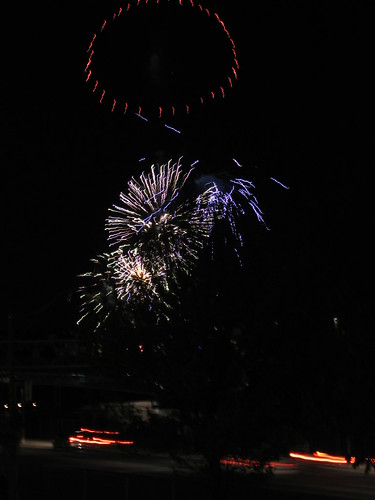
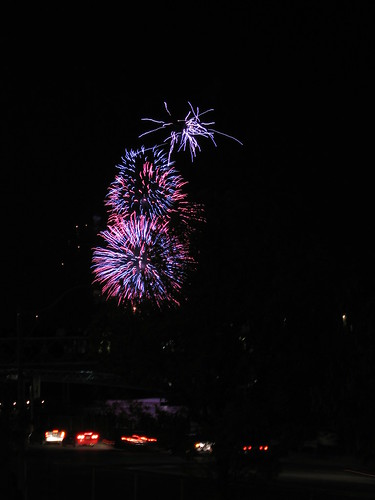
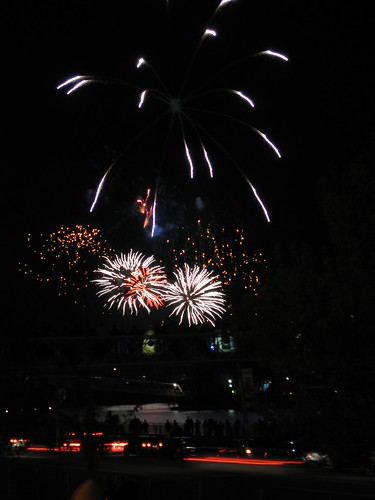
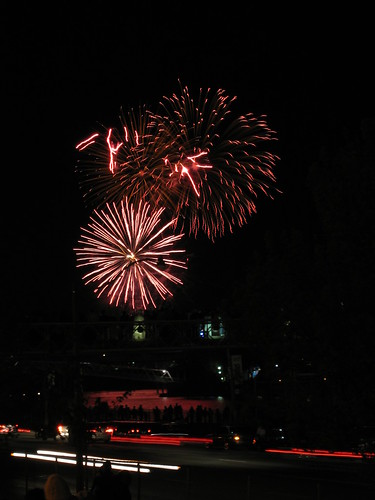
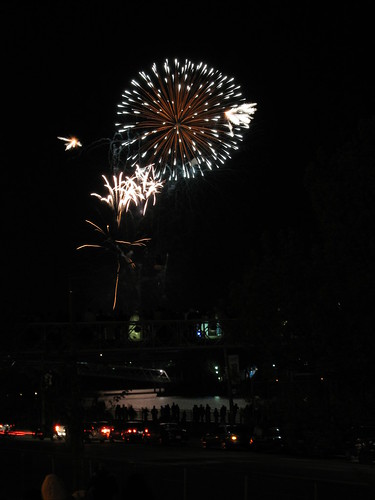
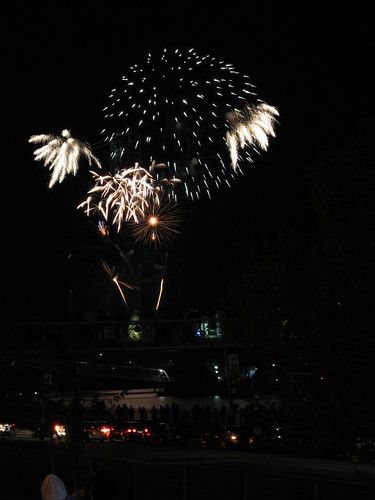
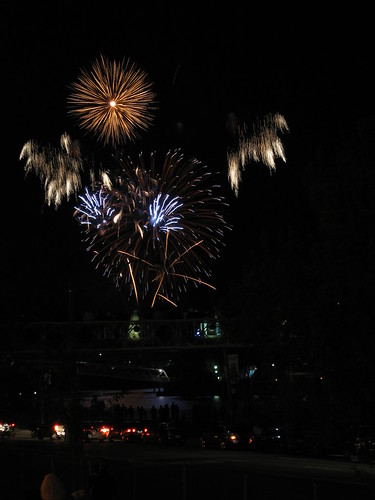
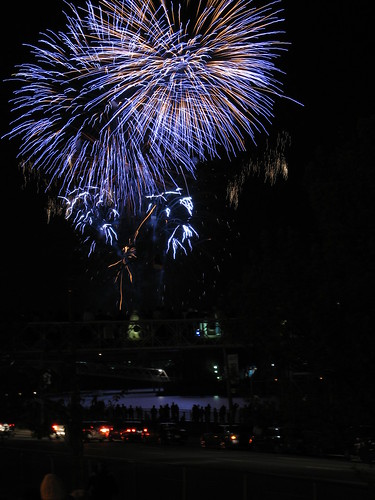
What follows are a couple of infrared, high dynamic range images taken with my Canon G1. They were made from 3-shot auto bracketing spreads, and in the case of the second, four of such. These were taken earlier on Victoria Day, around noon or not long after, at the Brickworks in the Don Valley.
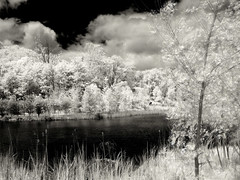
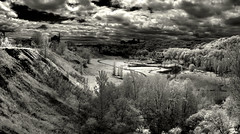
The Twilight Zone! ...and by "twilight", I mean...
But here's something I have noticed about the show. As intellectual as it was — and it touched on some pretty deep themes from time to time — they didn't always give the audience much credit. I don't know how many episodes I've seen now where the last two minutes of the show involve a Holmes-and-Watson routine where some guy explains the previous twenty minutes. And then, for good measure, Rod Serling would often use the closing voice-over to, once again, make sure the audience grasped the McGuffin. But once, just once, I would have liked to have seen Sherlock cut off at the knees by Watson: "You see, when the mind—" "—Yeah, I get it, Sam; the little girl was actually an illusion reflecting her own mental state, the flying saucer people are an allegory for our own military rapaciousness, the lifeguard at the pool no one else could see was a personification of Death because the guy was supposed to have drowned when he was seven at summer camp but didn't, blah blah blah blah blah, shut up and let's get a drink already."
My Twilight Zone episode? I get to go back in time and write this script. :)
Thursday, May 18, 2006
Franklin, Ben, I don't give a damn
A couple of days ago I was in a bargain store and I came across a beautiful hardcover called The First American by H. W. Brands, purporting to be the first substantial biography of Ben Franklin in sixty years. I haven't looked at the list price (it must be at least $30, probably more), but I got it for $5.99. It's as thick as your palm is wide, running over 700 pages before you hit the bibliography. I'm a chapter or two in at this point, and I'm looking forward to savouring it.
I've always had kind of an interest in Franklin. I find him the most interesting of the Founding Fathers of the United States. There's so much to plug into. First of all, he was far older than most of them, born at the very beginning of the 18th century, and spent nearly his entire life in the British Empire, a keen supporter of it. I discovered last year (somewhat to my shock and horror) that he had in his youth not only owned, but even occasionally traded slaves, but he is among the few who, during the course of his life, came to recognize the injustice of the institution and the human suffering it entailed, and turned against it. His views on the education and societal status of women were progressive (one is forced to wonder if he came to this as a result of his renowned lasciviousness, or vice versa). And while a strong believer in democracy and the American character, he was also a proponent of Britishness in the wider sense, and had he been heeded in London, the breech that became the Revolution might have been healed. Instead, the powers in London made of their greatest friend one of their bitterest enemies.
Franklin strikes me, out of all the US Founding Fathers, as the one who would most easily be at home in our own age... ironic since, again, he was the eldest of the well-known ones. Our scientific and social progress would probably surprise him but not distress him, on the whole, I think. My feeling is he'd get up to speed pretty quickly and start offering much-needed advice for the modern age. In the spirit of "Who would Jesus bomb?", I can't help wondering what Franklin would think of the current state and power of his country and its imperial involvements. Would he approve, thinking the subjects of them better off, or would he object, preferring instead that the right of nations to conduct their own affairs in peace be respected?
Nature trails, naturally

This is five shots combined with AutoStitch into one image, a parorama (obviously) of the treetops to the toetips. This is on a rise of land in Bruce's Mill Conservation Area, possibly the most-amenable park I've found for this kind of thing. It's beautiful, full of colours, scents, sounds, and textures. When the wind passes through the trees and you're alone with them, you could swear you're the only person on Earth and the world has always been this way and always should.
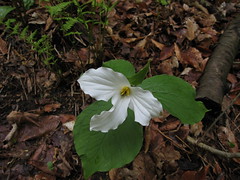
Right now, the park is alive — literally — with trilliums, the three-leaved white blossoms that are the floral emblem of the Province of Ontario.
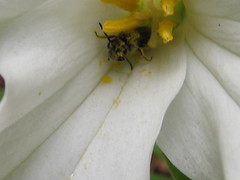
Inside that same trillium, I happened to notice this guy. A couple of days ago, I found the digital macro setting on my new Canon S80 (I know, I know, a tech writer who doesn't read the manual... but I'm an intermediate photographer! "Scene settings"? We don't need no stinking "Scene settings!"...). I've gotten some amazing results out of the patient use of that setting, so I switched to it and, after a few tries, got this. The lens probably got within two inches of this bug, but he never shied away, and never get nervous or threatening. It's almost as though he knew he was caught and was resolved to die. I know I'm reading too much into it, but that's how it seemed. I don't really believe he was happy and relieved when nothing of the sort happened, but I like to imagine he was.
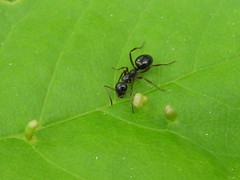
The digital macro setting was also useful in photographing this ant among these little pod things embedded in the leaf. I don't know what they were. I suspect they were eggs of some sort, probably due to hatch out into caterpillars of one kind or another. There were hundreds of them on the leaves of this tree.
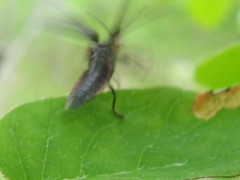
Here's a photographic Mexican stand-off... I wanted to photograph this beetle, but I think he had had enough of me and decided to take off without giving me a chance. Neither of us got quite what we wanted, but in the end I'm kind of pleased with the compromise we inadvertently worked out. :)
The other camera I was carrying with me yesterday was my Canon G1. I bought it on eBay several months ago and immediately sent it off to Melbourne to a pro photographer who reconditions several different models of digital cameras for shooting near infrared light (that's infrared light just outside the visible spectrum, as opposed to far infrared, the kind normally associated with heat-radiant bodies... near IR, like visible light, is reflected). The world of near infrared light is striking. It's familiar because the shapes and vista are what we see, but it's disturbingly or provocatively alien because the tonal cues are not what we expect, especially for cloudy skies and foliage. I love this kind of photography... it's like super black and white photography. For this outting, I had the G1 set to take bracketed exposures (three shots, -1, 0, and +1 stops up and down). A program called Photomatix can combine such spreads to express the tonal variation between them, and you can get some profound images that are often widely prized on Flickr. A lot of people do this with regular visible light images, but so far as I've seen, I'm on the only one doing this in infrared. That'll likely change, but I haven't seen anyone else do it yet.
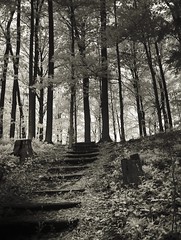
This is part of a set of stairs that leads you up to the rise where I took the first shot (the vertical panorama).

At the far end of the rise, at the very edge of the park, is a farmer's field I've always found lovely. This was assembled from seven AEB sets into seven HDR images using Photomatix, and then combined into one image using AutoStitch. What you're looking at here is actually the single expression of 21 exposures. As you might imagine, arriving at this result took a considerable amount of care and time.
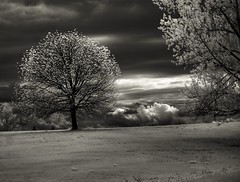
This is view from the field back near the parking lot, taken as I was ending my trek, walking now through the tame grass rather than the wild forest. To me, this image evokes the sense of something I yearned for as a boy: awaking in a strange new world where my potential was renewed and boundless.
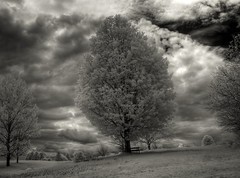
This one is garnering some nice comments on Flickr. It's from the same field as the previous shot. As I was putting the finishing touches on it, I was watching one of the very first episodes of Star Trek: the one where they pass though the energy barrier at the edge of the galaxy and two of the crew slowly become gods. The image really seemed to take on meaning for me when Kirk yells into the canyon at the unseen Gary Mitchell, "Above all else, a god needs compassion!"
Then I got back into my car and drove back to the shod(dy old) world. :)


